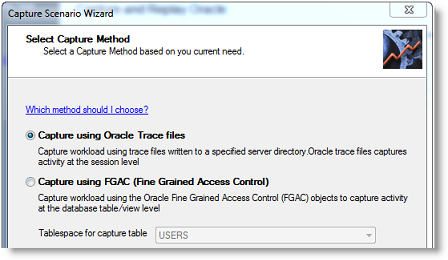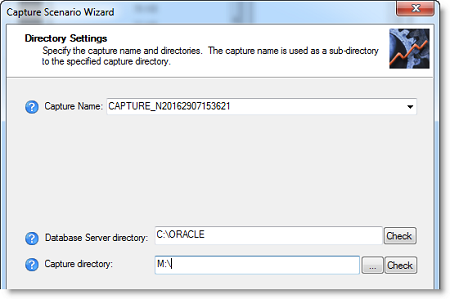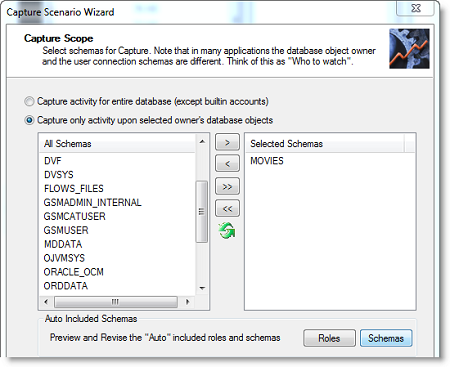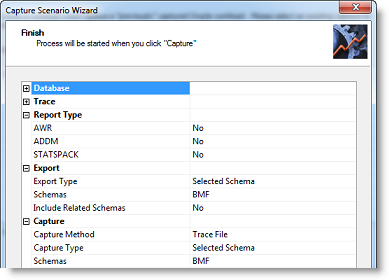This test type allows you to create load scenarios from one of the following industry standard benchmark tests: TPC-C, TPC-E, TPC-H, AS3AP, Scalable Hardware, TPC-B, or TPC-D. Each of these tests includes the steps to create/load all the required benchmark objects needed to execute the standard benchmark workloads. These synthetic workloads can be used when no real-world data is available to import for database load testing.
This test type also allows you to create a workload using the Benchmark Factory Replication test.
For more information, including a description of each of the standard benchmark tests included in Benchmark Factory, see Overview of Benchmark Testing.
To create an Industry Standard Benchmark test
Then select the type of benchmark test you want to use. Select each test to display a description in the lower pane.
 to add the test to the workload. The Summary tab opens.
to add the test to the workload. The Summary tab opens.
Summary tab. The Summary tab provides a summary of the job and the workload, as well as links to the commonly edited options for this test. Click each link to navigate to the applicable tab where you can edit that option. Options shown in red are required. Review the following for additional information:
| Scale | Click to change the scale factor for this test/step. In the Benchmark Scale field, specify a scale factor. See Benchmark Scale Factor for more information. |
| Size |
Displays the total size of all objects in this Create Objects step. Click to open the Scale tab where you can modify the database size or the scale factor. See Benchmark Scale Factor for more information. |
| Number of Tables | (Replication test only) Displays the number of tables to create. Click to modify the number of tables, the number of columns in a table, and the data types to create. See Replication Table Options Tab for more information. |
| Transactions | Displays the number of transactions. Click to modify the transaction mix for the transaction step. See Transactions Tab for more information. |
| User Load | Displays the user load—the number of virtual users per test iteration. Click to review or modify the user load. See Specify User Load for more information. |
| Length | Click to modify the timing for this test. See Timing Tab for more information. |
Create Objects - More Options. To specify more options for the Create Objects step, select the Create Object for test step in the left pane. Then select the Test Options tab. Review the following for additional information:
| Scale tab | See Benchmark Scale Factor. |
| Options tab | Use the Options tab to specify some general options for this step, such as specifying the number of agents to use to load data. See Options Tab (Create Objects Step). |
| Custom Creation SQL tab | Use the Custom Creation SQL tab to customize the SQL used to create objects in this step. See Customize SQL for Creating Objects. |
Transaction Mix - More Options. To specify more options for the Transaction Mix step, select the test Transaction Mix step in the left pane. Then select the Test Options tab. Review the following for additional information:
| Transactions tab | See Transactions Tab. |
| User Load tab | See Specify User Load. |
| Timing tab | See Timing Tab. |
| Advanced tab | See Advanced Tab. |
After specifying the test-level and job-level options, you can save the job, run the job, or schedule the job. Review the following:
 .
.
 . Use this option after scheduling a job.
. Use this option after scheduling a job.
 .
. The Replication benchmark test is a unique test developed by Benchmark Factory for testing replication in applications such as SharePlex.
This test allows you to create customized database objects, as well as a customized workload, in order to produce a repeatable database change rate and history (for example, Oracle redo logs) that can be used to test replication strategies. This test can also be used to create a model of your database and workload in order to help demonstrate replication performance.
While this benchmark was designed for testing and evaluating replication strategies and functionality in SharePlex, it can also be used to test other database replication products as well.
The following options can be customized in the Replication benchmark test:
To create a Replication benchmark test
 to add the test to the workload. The Summary tab opens.
to add the test to the workload. The Summary tab opens.
Summary tab. The Summary tab provides a summary of the job and the workload, as well as links to the commonly edited options for this test. Click each link to navigate to the applicable tab where you can edit that option. Options shown in red are required. Review the following for additional information:
| Scale | Click to change the scale factor for this test/step. In the Benchmark Scale field, specify a scale factor. See Benchmark Scale Factor for more information. |
| Size |
Displays the total size of all objects in this Create Objects step. Click to open the Scale tab where you can modify the database size or the scale factor. See Benchmark Scale Factor for more information. |
| Number of Tables | (Replication test only) Displays the number of tables to create. Click to modify the number of tables, the number of columns in a table, and the data types to create. See Replication Table Options Tab for more information. |
| Transactions | Displays the number of transactions. Click to modify the transaction mix for the transaction step. See Transactions Tab for more information. |
| User Load | Displays the user load—the number of virtual users per test iteration. Click to review or modify the user load. See Specify User Load for more information. |
| Length | Click to modify the timing for this test. See Timing Tab for more information. |
Create Objects - More Options. To specify more options for the Create Objects step, select the Create Object for Replication step in the left pane. Then select the Test Options tab. Review the following for more information:
| Scale tab | See Benchmark Scale Factor. |
| Table Options tab | Use the Table Options tab to specify options such as the number of tables, number of columns, column data types, and data type percentages. See Replication Table Options Tab. |
| Options tab |
Use the Options tab to specify some general options for this step, such as specifying the number of agents to use to load data. See Options Tab (Create Objects Step). Object/Data Retention Method - Special Considerations
|
Replication Test - More Options. To specify more options for the Replication step, select the Replication Test step in the left pane. Then select the Test Options tab. Review the following for more information:
| Transactions tab | See Transactions Tab. |
| User Load tab | See Specify User Load. |
| Timing tab | See Timing Tab. |
| Advanced tab | See Advanced Tab. |
After specifying the test-level and job-level options, you can save the job, run the job, or schedule the job. Review the following:
 .
.
 . Use this option after scheduling a job.
. Use this option after scheduling a job.
 .
. Notes:
Capture/Replay tests allow you to capture and then replay a workload, or replay an existing capture from a trace file, database repository, text file, or output from another Quest Software tool.
Select one of the following topics for more information:
Benchmark Factory allows you to capture Oracle workloads, then replay those workloads to view transactions and response times.
In Benchmark Factory, use one of the following workflows to capture an Oracle workload:
Note: This feature is not available in the freeware edition of Benchmark Factory.
See also, Considerations When Performing an Oracle Capture and Replay.
To capture an Oracle workload
 .
.
 .
.
On the Replay Workload page, click Perform New Capture. The Capture Scenario Wizard opens and the New Job Wizard closes.
Tip: You can also create a new capture using the same settings as an existing capture project. In the Captures tab of the Benchmark Factory console, right-click a capture and select Repeat Capture.
Capture Scenario Wizard. In the Capture Scenario Wizard, enter connection information for the database from which you want to capture a workload.
Select Capture Method. On the Select Capture Method page, select a capture method to use. Review the options below. Click Next when finished.
| Capture using Oracle Trace files |
Captures workloads using trace files written to a specified server directory. These files are captured at the session level. Note: The Trace file capture method is not available for Oracle connections that use Real Application Clusters (RAC). |
| Capture using FGAC (Fine-Grained Access Control) |
Captures workloads using the Oracle Fine-Grained Access objects that capture activities at the database table and view levels. Tablespace for capture table—Allows you to select the required tablespace for Fine Grained Access captures. Note: The FGAC capture method is enabled only if the feature is available in the target database. |

Apply Privileges. If the user does not have the required privileges to do the capture, the Apply Privileges page opens. Enter the credentials of a DBA-type user account that can apply the necessary privileges. Click Next when finished.
Note: To view the missing privileges necessary for this user to perform the capture process, click the View/Save Script button and review the script.
Directory Settings. On the Directory Settings page, specify an Oracle server-side directory in which to place the capture files. Also, specify the capture directory from which Benchmark Factory will replay the files. Review the following for additional information:
Click Next when finished.
| Capture Name |
Enter a name for the capture, or use the default. This name is used for the sub-directory where the capture files are stored in the Capture Directory you specify. Note: Only alpha and numeric characters and the underscore (_) are permitted. The name must begin with a letter. |
| Database Server Directory |
Specify an Oracle server-side directory where Benchmark Factory should place the capture files. Specify the path as the server sees it. Note: You can specify a network directory here. Enter the full network path to the network directory. The database service must be able to access the network directory. In a Linux environment, a local directory must be mounted to the network location. |
| Capture Directory |
Specify a directory where Benchmark Factory will look for the capture files to replay. Do one of the following:
Selecting a shared directory: The shared capture directory can be on the database server as a local directory or on a network file server as a local directory. Either location must be accessible by the Benchmark Factory client computer (Windows network share, Samba, or NFS). A network file server is the preferred location for the following reasons:
|

Reporting method. On the Reporting Settings page, select the performance reporting method to use. Review the options below. Click Next when finished.
| Reporting Method |
Select a performance collection and reporting method.
|

Capture Scope. The Capture Scope page allows you to select schemas for capture. You can select the entire database or use the list to select specific schemas. Review the options below. Click Next when finished.
| Capture activity for entire database |
Captures activity for the entire database, but not for built-in accounts. |
| Capture only activity upon selected owner's database objects |
Captures only the data of the selected database objects. This option allows you to select individual schemas for capture.
|

Export Scope. The Export Scope page allows you to specify whether or not to export the database objects and data required to replay the workload on the same data snapshot. Review the options below. Click Next when finished.
| Perform export as part of capture process |
Select to instruct Benchmark Factory to export the objects selected on the previous page (Capture Scope). The export is performed during the capture procedure. Note: If you selected to capture activity for the entire database, exporting the entire database can require significant time and space. Include export of related schemas—Select to export the auto-included schemas selected on the Capture Scope page. |
To add a filter, click Add. Then specify parameters for the filter. Click Next when finished.
Capture Thresholds. Benchmark Factory allows you to specify limits for CPU usage and free space during a capture. If levels exceed the values you specify, the capture process is stopped.
Benchmark Factory displays the current values to help you determine the best thresholds to specify. Review the options below. Click Next when finished.
| Stop capture if CPU percentage exceeds | Enter a percentage. If CPU usage exceeds this value, Benchmark Factory stops the capture process. |
| Stop capture if disk/tablespace free space falls below | Enter a value for free space in MB. If the amount of free space falls below this level, Benchmark Factory stops the capture process. |
Capture Control. Use the Capture Control page to specify when to start the capture.
You can start the capture immediately after finishing the wizard, or you can schedule the capture. Review the options below. Click Next when finished.
| Start Capture/Export |
Immediately—Select to start the capture process immediately. Scheduled (via database schedule)—Select to schedule the capture process. Then specify a date and time based on the server time. |
|
Capture Automatically |
Stop After—Use the sliders to specify a duration for the capture process. The default is 30 minutes. |
Start the capture. The Finish page provides capture specifications. To start the capture (or enable the schedule), click Capture.

Capture Status. The Capture Status window opens providing export or capture status and process details.
Immediate capture: If you selected to start the capture immediately, the Capture Status window displays information about the capture process, such as the status of the export process and the number of sessions captured.
Scheduled capture: If you scheduled the capture process, leave the capture wizard open to run the capture at the scheduled time.
If you specified a client-side directory (instead of a shared directory) as the Capture Directory (directory from which the client replays the capture), BMF prompts you to transfer the capture files to your client-side directory now. Copy or move the trace/xml and export (DMP) files from the directory where they were generated (Database Server Directory) to the client-side Capture Directory. Place the files into the existing capture-named sub-directory. After transferring the files, click OK in the message box. BMF then processes the necessary files and updates the project file.
Optionally, if you want to transfer the files at a later time, click Cancel.
To replay an Oracle workload
 .
.
 .
.
Benchmark Factory loads the capture details into Capture Properties fields.
When the process is finished, close the Capture Status window. Then open the New Job Wizard again and select the project (.mse) file again.
 . The test is added to the workload and the test Summary page displays.
. The test is added to the workload and the test Summary page displays.
To jump to the Test Options tab, click Test Options at the bottom of the Summary page. Review the following for more information:
| Tab | Description |
|---|---|
| Transactions tab |
Modify the transactions and the transaction mix for the test. For a custom test, add transactions. |
| Options tab | Enable scaling for the user scenario. See Options Tab (Capture/Replay) for more information. |
| Timing tab |
User Startup—Select one of the following options:
|
| Advanced tab |
Specify Repository options, error handling, and connect/disconnect options for the test. See Advanced Tab for more information. |
After specifying options for this test, you can add another test to the job, configure job setup options, save and close the job, run the job, or schedule the job. For more information about each of these steps, see Quickstart: Create a New Job.
| Consideration | Description |
|---|---|
| Trace file capture and replay times (AWR) might not match |
When using trace files as the capture method, you could find that the replay time as reported by the AWR does not match your specified capture time. Benchmark Factory trace method only captures sessions that are initiated after the capture starts. If there is a lag between when the capture starts and when the first session is captured, this lag is reflected by the mismatched times. |
| Oracle Enterprise Manager TPS results | If you choose to collect database wide performance statistics from the AWR, the TPS results from Benchmark Factory and Oracle Enterprise Manager may not match. This is because Benchmark Factory displays TPS for the workload, while OEM displays TPS for all the work the server is doing. |
Notes: